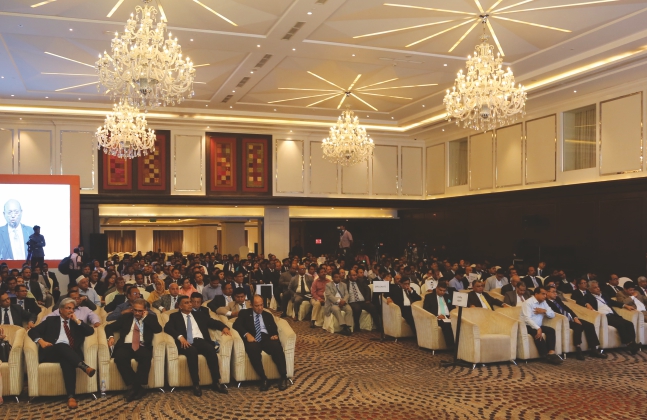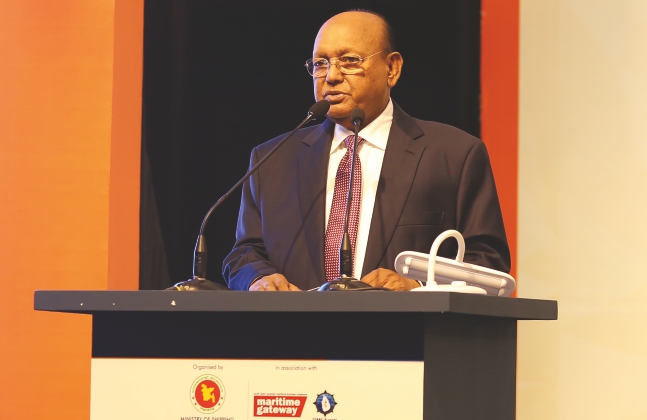Key stakeholders from the Bangladesh maritime fraternity deliberated on the current status of maritime and logistics infrastructure in the country and development plans on the drawing board
At the outset, Moderator and Chairperson, Kazi M Aminul Islam, Executive Chairman, Bangladesh Investment Development Authority (BIDA) Bangladesh, called for a clear focus on improving logistics. Bangladesh has the second largest RMG sector in the world but the profit margin in this sector is becoming slim by the day. “We have to improve our competitiveness by upgrading our services. One of the important areas in this regard is maritime logistics,” he pointed out. Bangladesh has made phenomenal progress since 2009 and its growth this year is around 8 per cent. The economy is expanding and getting more integrated with the global economy. Expanding economy, growing middle class and integration with global economy indicate that the country can better benefit with improvement in logistics.
“Significant developments are on the cards. In June 2015 Bangladesh and India signed the coastal shipping agreement and in October 2018 Bangladesh and Sri Lanka are close to finalise a coastal shipping agreement. Combining these two developments, there is a tremendous business case coming up,” noted H.E. Riaz Hamidullah, Hon’ble High Commissioner of Bangladesh to Sri Lanka. Chittagong and Colombo get connected and this will make vessels to call on third country ports, which will be essentially India’s east coast. A new supply chain and value chain will come up. If we add the BIMSTEC coastal shipping agreement to this scenario, then it will unlock the potential in the Bay of Bengal. Talks are in progress among India, Bangladesh and Sri Lanka for SEPA. We need to explore how soft infrastructure like Block Chain can help connect in a nascent landscape like Bangladesh. Coming to multimodal connectivity for hinterland, another scenario Hamidullah shared was about linking Dhaka and Delhi through a container train.

India is working towards seamless connectivity from Assam to Colombo using coastal shipping and inland waterways. Laugfs Gas is looking at using Hambantota Port as an energy hub for feeding into Mongla Port, this makes for another tremendous business case. The point here is how can Bangladesh get prepared to get maximum benefit out of these? Hamidullah also hinted at the need to revisit the policy and regulatory framework of Bangladesh considering its impact on trade with the neighbouring nations.
Md. Abdus Samad, Secretary, Ministry of Shipping, Government of People’s Republic of Bangladesh, briefed on the status of maritime infrastructure in Bangladesh and development plans. Bangladesh’s exim trade is growing at 14 per cent annually and Chittagong Port plays a key role in this as it handles about 4000 ships annually. Infrastructure at the Port is being upgraded with construction of new jetties and terminals. Plans are onboard to further add 25 more jetties to Chittagong Port and more quay cranes will be installed which will drastically improve the turnaround time for ships. New jetties are also being planned at Bay Terminal. Activity at Mongla Port has also increased and the port now handles about 700 ships in a year. More Jetties and terminals are being added to Mongla Port along with cargo handling equipment to increase its capacity. Payra Port is being developed and will be ready in two years for mother vessels to call. Port at Matarbari is being developed with help from JICA. It will be another deep seaport with 16 meters draft.
At Mirsarai about 100 economic zones are being developed and to connect these industrial clusters a port is also being planned in that location. About 30 river ports are being developed to enable quick movement of cargo and to decongest roads.

Government of the Peoples Republic of Bangladesh addressing
the audience
“Bangladesh’s exports in 1972- 73 were $348 million and comprised of 25 items, of which three items including jute, tea and leather had a major share,” remarked H.E. Tofail Ahmed, MP, Hon’ble Minister, Ministry of Commerce, Government of People’s Republic of Bangladesh, as he compared the current scenario in Bangladesh with that during the early days of independence. Current trade of Bangladesh stands at $37 billion in exports during 2017-18, while the service sector has recorded $41.5 billion. GDP of Bangladesh in 2017 was 7.86 per cent and the current year will exceed 8 per cent. He read out the investment opportunities for private sector which include Laldia Terminal that is being developed on PPP basis, Matarbari deep seaport is being developed for which JICA has completed the feasibility study, a floating terminal for LNG is also coming up at Matarbari. As he concluded, Tofail Ahmed repeated the vision of Prime Minister Sheikh Hasina, to make Bangladesh a developed country by 2041 and the exports will touch $100 billion by that time.







